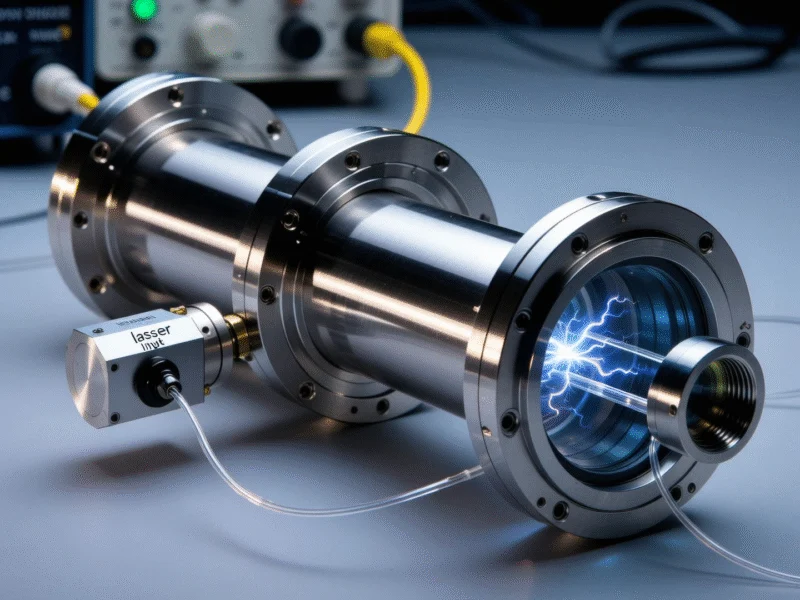Breakthrough in Muon Generation
Scientists at Berkeley Lab have unveiled a revolutionary compact laser-plasma accelerator (LPA) that can generate muon beams on demand in a device measuring just 30 centimeters long. This groundbreaking development, detailed in a comprehensive study published in Physical Review Accelerators and Beams, represents a significant leap forward in particle acceleration technology and non-destructive imaging capabilities.
The foot-long device overcomes the limitations of conventional artificial muon sources, which are typically bulky and expensive, forcing many imaging applications to rely on naturally occurring cosmic rays. According to the research team, the new LPA produces muon yields significantly higher than traditional methods, reducing exposure times from months to mere minutes for detailed imaging applications.
How the Compact Accelerator Works
At the heart of this innovation lies the laser-plasma acceleration mechanism. Researchers at Berkeley Lab’s BELLA Facility used intense laser pulses to accelerate electron beams to extremely high multi-GeV energies within a 30 cm plasma channel. These high-energy electrons then collided with a high-atomic number target (lead), where they emitted photons as they were deflected by atomic nuclei.
The process continues when these energetic photons strike the target nuclei, producing muon-antimuon pairs. The resulting muons form a highly directional, collimated beam along the original electron path, with energies reaching several GeV. This directional quality is crucial for practical imaging applications, as noted in recent technological advancements in scientific instrumentation.
Superior Imaging Capabilities
Muon imaging offers distinct advantages over conventional methods like X-rays. While X-rays are easily absorbed by dense materials, muons lose energy gradually, allowing them to penetrate large or hidden structures composed of hundreds of meters of rock or dense materials like lead and steel. This exceptional penetration power has already demonstrated its value in archaeological discoveries and geological surveys.
The technology has previously revealed hidden chambers in the Great Pyramid of Giza, probed the interiors of active volcanoes, and enabled inspection of nuclear waste containers. However, these applications have been limited by the scarcity and unpredictability of naturally occurring muons from cosmic rays.
Experimental Breakthrough and Results
Previous studies had only theorized that LPAs could generate muons as a byproduct of colliding laser plasma-generated electron beams with high-Z targets. The Berkeley Lab experiment marks the first successful detection and characterization of directional muon beams produced by a laser-plasma accelerator.
Simulations and experiments revealed two distinct muon populations: high-energy, directional muons concentrated along the central beam axis, and lower-energy, nondirectional muons dominating regions away from the central beam. The LPA generated muon fluxes more than 40 times higher than cosmic rays for horizontal imaging, delivering over 20 muons per shot within the imaging aperture.
Practical Applications and Future Implications
The compact nature of this technology opens up numerous practical applications. Unlike traditional muon sources that require massive infrastructure, this foot-long device can be transported to various sites for on-demand imaging. This portability aligns with growing trends in field-deployable scientific equipment that can operate in diverse environments.
Researchers emphasize that their experiment establishes LPA-generated electron beams as practical muon sources, paving the way for future applications built around high-energy beams and detectors optimized for muon scattering image reconstruction. The technology promises to revolutionize fields including archaeology, geology, nuclear safety, and security screening.
Overcoming Traditional Limitations
Natural cosmic rays constantly shower Earth with muons—approximately 147 muons pass through every square meter of the surface each second, and trillions pass through each person over a lifetime. However, imaging applications require muons from specific directions, which is why traditional muon imagery requires months of exposure to collect sufficient data for clear images.
The new LPA technology addresses these limitations comprehensively, offering directional control and significantly higher flux rates. This breakthrough comes at a time when scientific data collection and analysis methods are rapidly evolving across multiple disciplines.
The research team’s successful demonstration of a compact, efficient muon source marks a turning point in particle physics applications, potentially making sophisticated imaging technology accessible to a wider range of scientific and industrial users while dramatically reducing both the time and cost associated with muon-based investigations.



